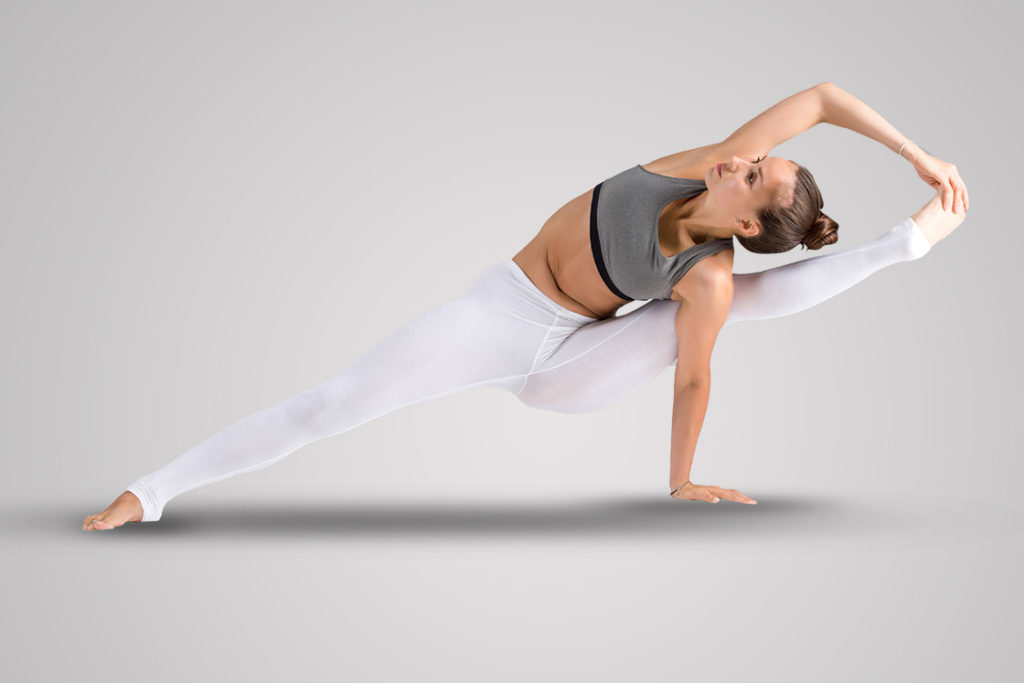
| Sanskrit Pronunciation | Visvamitrasana (Vishwa-mit-Ra-AHS-anah) |
| Meaning | Sage Visvamitra’s Pose |
| Pose Type | Sitting side bend |
| Pose Level | Advanced |
| Focused muscles | Quadriceps, Hamstrings, Biceps and triceps, Core |
| Other Names | Visvamitra’s Pose, Flying Warrior Pose, Compass Arm Balance |
Visvamitrasana, named on sage Visvamitra, is an advanced combination of balancing and twisting pose.
In Visvamitrasana, the legs are stretched apart in a split while the torso extending towards one lifted leg. It acts as a hip opener, shoulder opener, hamstring stretch, and almost twist the entire body. Hence considered a good pose for the musculoskeletal system.
This yogic process has widely practiced leaping into the finer and improved version of self than ever before. By practicing this asana one can incorporate a sense of balance, rhythm, and flow in their day-to-day body movements. However, dedication toward this pose energizes the entire persona of a person and lets him/her feel more alive.
Visvamitrasana Meaning
Visvamitrasana is the pose named after a king-turned-sage Visvamitra. The meaning of Vishwamitra is; Visva means ‘the world’, Mitra means ‘a friend’. Sage Visvamitra is known for his yogic power of compassion towards all the people he used to meet. This pose gives an opening to the heart i.e. compassion center in our body, so Visvamitrasana is dedicated to sage Vishwamitra.
This asana not just provides strength and vigor, which utilizes the prana to nourish the life but also helps in establishing a balance within. So, the practitioner is able to tune in with their surroundings and react in a friendly manner to keep humanity alive for the ages.
Everything becomes possible from the inside and Visvamitrasana as the name suggests grants the ability to the inner self of being an open ocean of happiness. So the people around can see the infiniteness of possibilities that each one of us has. By combining these possibilities one can set up a horizon of immense vision that nourishes the ecology of the subtle inner self.
Story of Sage Vishwamitra
Sage Visvamitra is one of the seven wise sons who born from the mind of Brahma (The God of creation in Hinduism). One day, king Kaushik (earlier name of Vishwamitra) saw a cow named Nandini who is possessed by the Maharishi Vashishta and has a boon to grant everything to the one who asked. Vishwamitra wished to possess the cow. He asked Vasishtha to allow him to take the cow with him, to which Vasishtha denied and said this belonged to devas (god), not to him. To which, King Kaushik became angry and attacked Vasishtha. However, he was defeated by the vasishtha’s power of penance.
All of a sudden Vamadev (preserving an aspect of the God Shiva) appeared and saved Kaushik from Vasishtha. To the surprise of Vasishtha, Kaushik asked vamadev how he’s such a powerful. Vamadev replied it is all due to Vasishtha’s Brahmashakti. Kaushika then wanted to become like Vasistha. Doing penance guided by Vamdeva, King Kaushika became Vishwamitra.
Visvamitrasana Practice Guide
By following the steps given below one can practice this pose safely.
Contraindications of Visvamitrasana
In the following conditions, Visvamitrasana should not be practiced;
- Practitioners with hamstring Syndrome should avoid practicing Visvamitrasana. This might pressurize the nerve that may be pinched between the hamstring muscles and pelvic bone. It would be painful if ignored.
- Pregnant women should refrain from practicing Visvamitrasana. The intense stretching of the abdomen might squeeze the stomach which would not be appropriate in such a situation.
- Practitioners with injuries to the shoulder, elbow, wrist, ankle, neck, spine, and knee should not practice until or unless the condition becomes normal. However, continuing could further bring serious health issues.
- Those who have undergone surgery on the abdomen, waist lower back, knee, and shoulder should avoid or weigh till recovery. After recovery, one should consult their doctor before beginning the practice.
Preparatory Poses
- Utthita Parsvakonasana (Extended Side Angle Pose)
- Parivrtta Janu Sirsasana (Revolved Head-to-Knee Pose)
- Parivrtta Upavistha Konasana (Compass Posse)
Visvamitrasana Steps
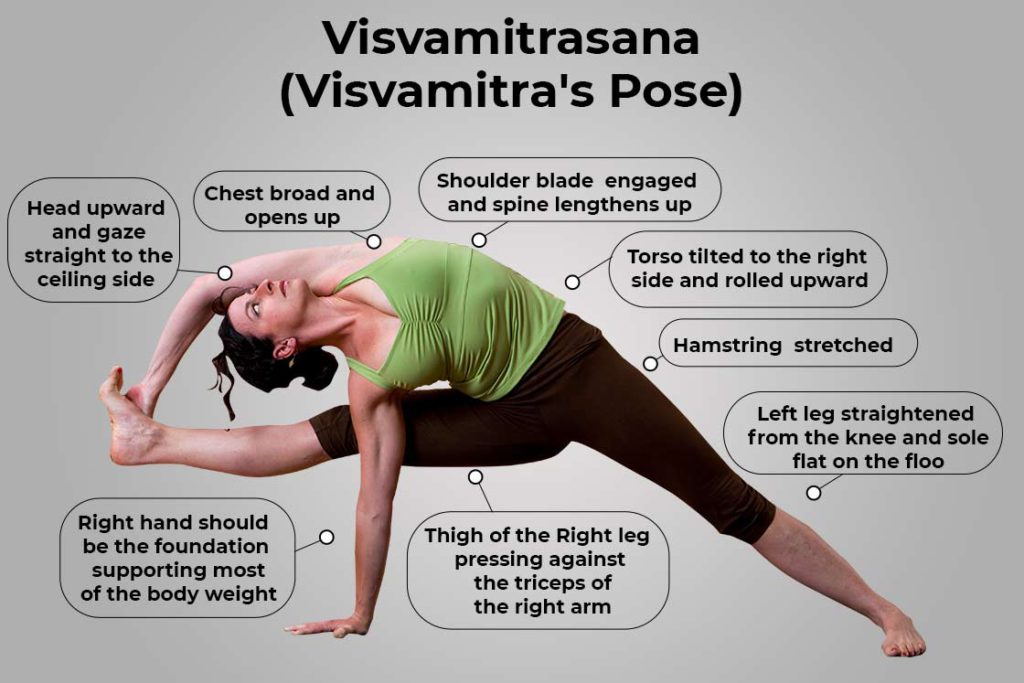
- Begin by coming into the Adho mukha svanasana and maintain here for a few breaths. Now, inhale and lift your right foot and place it just beside the right palm outwardly.
- After that, flat your left foot in a manner with toes pointing outward. Now, lift your right arm to bring it in front of your foot and allow your right shoulder underneath your knee.
- As you firm your left foot on the mat, you are about to jump into the final pose. Now, by pressuring the outer edge turn foot outside in a direction facing your left body.
- Now, lift your right thigh upward and let your body slightly drop to the right side. From here, your right-hand holds the bodyweight while your left foot remains flat on the mat.
- Now, try to wrap your left hand around the toes of your right foot and then, inhale to extend your right leg in a way that it’s sole facing in the direction you are facing.
- Open your chest upward and lengthen your spine along with a gaze to the ceiling side and maintain it here for as long as you are comfortable.
- Now, slowly release the attachment of the left hand and right foot. Bend the right knee and drop your leg to return into the Adho Mukha Svanasana.
Precautions
One should take precautions in visvamitrasana to avoid any serious injury or muscles tearing;
- While taking the right foot beside the right hand, practitioners should make sure that their right knee aligns beside the armpit. This ensures the stability of the pose.
- Keep the foot foundation strong in of the pose when you lift one hand slowly to bring it around the front of the opposite foot. There might be the chances of falling behind as both legs stretched position.
- One should try to keep the body in the same plane and avoid any kind of compression in their lower back by the broadening of the sacrum. Such positioning sets up an overall balance in the posture.
Beginners Tips
- In an attempt to reach the right foot by the right hand over the head, beginners might face difficulty due to a stiffened shoulder. So initially in visvamitrasana, just lift the hand over the head and stretch it upwards only using a rope or support.
- Due to stiffened hamstrings, beginners may find it hard to perform this pose in a go. Therefore, they should perform this asana with patience and avoid forcing the pose. However, one can work on their hamstring to discover ease in practice.
- Practitioners having difficulty in balancing the posture should press the inner thigh of the extended leg against the triceps of the foundational hand. It will grant the necessary support to posture.
Props and Modifications
Beginners may find it helpful to perform visvamitrasana with some modifications. Use different props like a block, strap, and chair to get a better balance in visvamitrasana;
- Due to the less height of the torso in visvamitrasana there might be some chance of leaning to either side. So, to avoid this practitioners can use blocks under their foundational hand to achieve height. This will decrease the intensity of the side stretch and make the pose more determinable.
- If the practitioners are unable to reach the foot from their hand over the head. To reach that foot they can bind the strap to their extended foot and then hold it by the hand over the head.
- If the practitioners find difficulty in lifting their extended leg up, then they can use a chair and place their leg on it. Afterward, slowly reach to the foot of the extended leg and refine their posture.
Variations
By altering some body parts placement the practitioner can perform the following variations of Visvamitrasana.
1. Ardha Visvamitrasana
In this asana, the extended leg is not that stressed as in Visvamitrasana, where the practitioner goes for the maximum extension. One leg in ardha Visvamitrasana pose is placed on the floor via knee, making it less challenging than the base pose, whereas the left leg remains stretched in the base pose.
Begin by coming into Adho Mukha svanasana and then place your right leg beside the right hand outwardly. Now, bring your right hand in front of you by tilting your body to the left and place your left knee to the floor in a manner with the upper thigh facing the direction of your right hand. Now, reach to the right foot by the left hand on lifting both simultaneously and maintain here for some time. Then return by dropping the right leg and by lifting back the left knee.
2. Utthita Parsvakonasana (Extended Side Angle Pose)
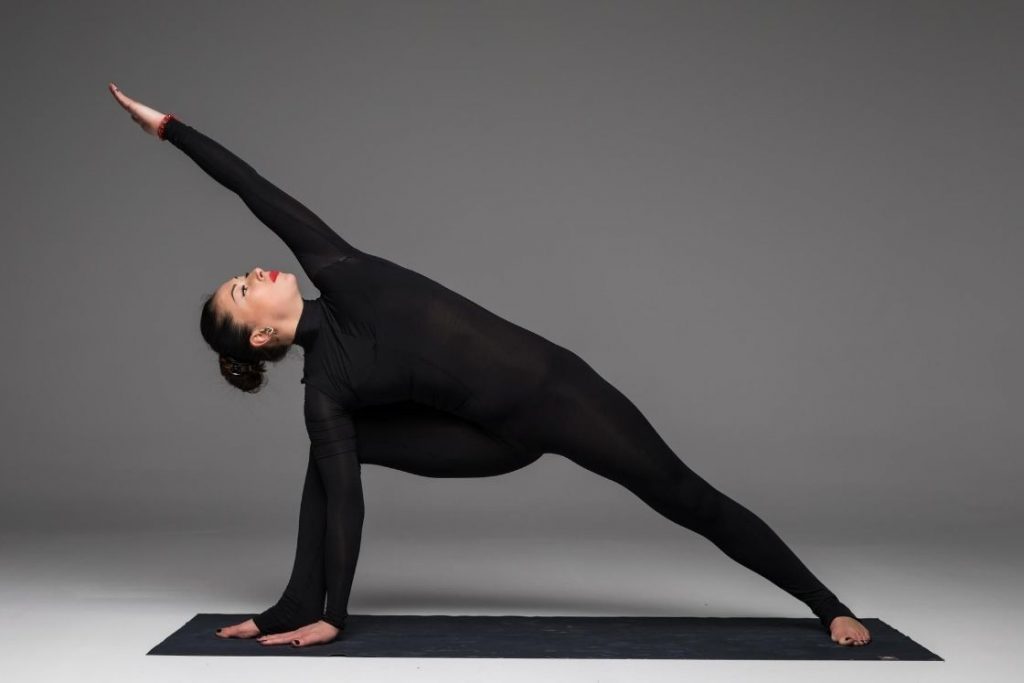
In the Visvamitrasana, the right leg remains lifted and extended, which is grabbed by the right hand over the head, whereas in Utthita Parsvakonasana the left leg remains straight behind the body and the right leg is at the 90’ degree. And the right hand placed beside the right foot from inside and the torso rolled in upward long with gaze and left hand in the same direction.
Begin by going into the warrior pose where your right leg is at 90’ degrees while the left leg is straightened behind the body and hand raised in namaste mudra. From here, drop your torso from the right side to place the right hand beside the right foot from inside. Now, roll your torso upward to raise your left hand straight into the sky. Shift your gaze in the direction of your left hand and maintain it here for some time. Then return by bringing the left hand down and lifting the torso back in warrior pose and, then relax.
Therapeutic Benefits
- The challenging nature of Visvamitrasana offers the opening of the chest, which improves the respiratory capacity and aids in breathing.
- Hip opening in this pose ensures more range of motion, this allows for better circulation and more support for the muscles of the back.
- Our tummy and waist remain cinched in Visvamitrasana, so the opening of the waist brings postural alignment and also aids in the engagement of the core muscles.
Visvamitrasana Benefits
Visvamitrasana is a great stretching pose for hips and leg muscles. It gives a gentle twist to the upper body including the chest and shoulder, at the same time releases any tension from the lower back.
Below are explained some major benefits of Visvamitrasana.
1. Strengthens bones
Due to few points of attachments of the body from the floor, the weight of the body distributed accordingly. As a result, those body parts and their surrounding structures suffer gravitational force, which helps the bones absorption of more calcium from the blood. Hence, make them stronger.
2. Promote Respiration
The rolling of the chest upward while practicing Viswamitrasana helps in chest opening, which also assists lungs in optimum breathing. This results in the improvement of lung capacity, thus, allows them to deliver more oxygen throughout the body. Therefore promotes respiration.
3. Improve Flexibility
This asana is an effective approach for the increment in the body’s movements. The twisting and extension while practice stretches muscles and allows them to raise their threshold in the sense of flexibility. This sets up a new boundary with every attempt of practice.
4. Massages Abdominal Organs
Twisting and turning to give a massaging effect over the abdominal organs, which stimulates the blood circulation in the blood vessels of the abdominal cavity. As a result, it nourishes the kidney, pancreas, gallbladder, stomach, small and large intestines, and liver, etc.
5. Activates Mooladhara Chakra
Visvamitrasana involves hip-opening which affects the seat of the Mooladhara chakra or Perineum. Hence, with appropriate alignment and breathing techniques, one can find the way through the activation of Root Chakra. This helps the practitioner with vitality, vigor, and growth.
6. Helps in Sciatica
Twisting or the simple stretch helps relieve sciatica pain. Therefore, practicing Visvamitrasana helps in loosening your gluteal and piriformis muscles, which can become inflamed and press against the sciatic nerve. Moreover, it also helps in alleviating the lower pain in regular practitioners.
Conclusion
The furious king turns into a humble sage, Vishwamitra and his asana not just teaches the world to live together with a friendly approach but also helps in restoring their optimum health and wellness.
Due to advanced level, the practitioner might see it with various physical and mental challenges. However, once they reach the final point in the posture then they realize the true potential of this powerful asana. So, one should practice daily to tunefully with this asana.
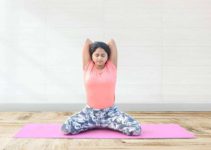
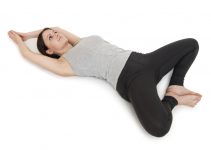
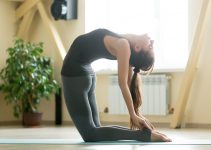
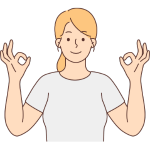
 Oct 24th to 30th
Oct 24th to 30th Learn Mudras
Learn Mudras  Deepen Your Practice
Deepen Your Practice  Find Inner Peace
Find Inner Peace